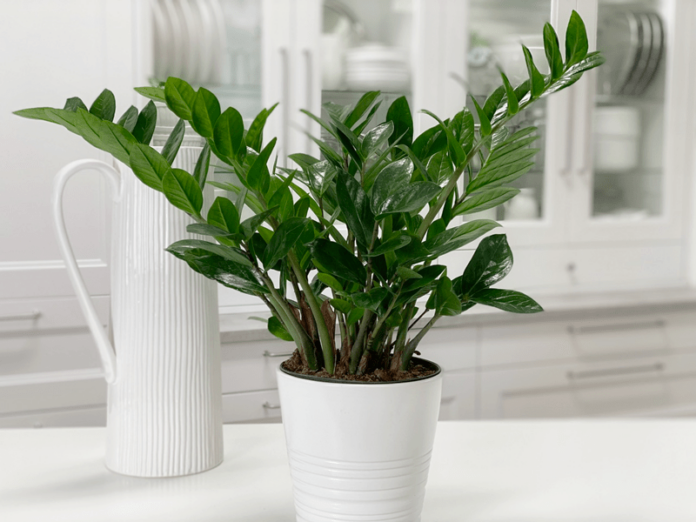The ZZ plant, also known as Zamioculcas zamiifolia, is a popular houseplant known for its attractive, glossy leaves and its ability to thrive in low light conditions. This resilient plant is perfect for beginners and those with a busy lifestyle.
In this guide, we will cover everything you need to know about ZZ plant care, from its ideal growing conditions to troubleshooting common problems.
What is a ZZ Plant?
The ZZ plant is a tropical perennial native to Eastern Africa. It’s known for its thick, waxy leaves that grow from rhizomes, which are underground stems that store water. This unique feature allows the plant to survive in low light and drought conditions, making it an excellent choice for indoor environments.
| Aspect | Details |
|---|---|
| Scientific Name | Zamioculcas zamiifolia |
| Common Name | ZZ Plant |
| Appearance | Glossy, dark green, waxy leaves; grows upright with a bushy, compact form. |
| Care Level | Low-maintenance; ideal for beginners. |
| Light Requirements | Tolerates low light but thrives in bright, indirect light. |
| Watering Needs | Drought-tolerant; water when the soil is completely dry. |
| Ideal for | Indoor spaces, low-light areas, and as an office plant. |
Ideal Growing Conditions
The given are the ideal growing conditions:
Light
ZZ plants are incredibly adaptable when it comes to light. They can thrive in low light conditions, making them perfect for offices and rooms with minimal natural light. However, they also do well in bright, indirect light. Avoid placing your ZZ plant in direct sunlight, as this can scorch the leaves and cause damage.
Watering
One of the most important aspects of ZZ plant care is watering. ZZ plants are drought-tolerant and can go for weeks without water. Overwatering is a common mistake and can lead to root rot. Allow the soil to dry out completely between waterings. When you do water, soak the soil thoroughly and let excess water drain away.
Soil
ZZ plants prefer well-draining soil. A mix of potting soil and cactus or succulent soil is ideal. This type of soil allows excess water to drain away quickly, preventing the roots from sitting in water and reducing the risk of root rot.
Temperature and Humidity
ZZ plants thrive in average household temperatures, typically between 65-75°F (18-24°C). They can tolerate a range of humidity levels but prefer slightly higher humidity. Avoid placing your ZZ plant near drafts, air conditioners, or heaters, as sudden temperature changes can stress the plant.
Feeding Your ZZ Plant
ZZ plants are not heavy feeders but benefit from occasional fertilisation. During the growing season, which is typically spring and summer, feed your ZZ plant with a balanced, water-soluble fertiliser every 4-6 weeks. Reduce feeding during the fall and winter months when the plant’s growth slows down.
Pruning and Repotting
Here is how to do:
Pruning
Pruning is not usually necessary for ZZ plants, but you can trim away any yellow or damaged leaves to keep the plant looking its best. Use clean, sharp scissors or pruning shears to make clean cuts, and avoid cutting into the rhizomes.
Repotting
ZZ plants grow slowly and typically only need to be repotted every 2-3 years. When repotting, choose a pot that is one size larger than the current pot and ensure it has drainage holes. Remove the plant gently from its pot, being careful not to damage the rhizomes, and place it in the new pot with fresh soil.
Common Problems and Solutions
Some of the common problems and solutions are:
Yellow Leaves
Yellow leaves are often a sign of overwatering. Check the soil moisture and adjust your watering schedule accordingly. Ensure the pot has proper drainage and that the soil is allowed to dry out between waterings.
Brown Tips
Brown tips on the leaves can be caused by a variety of factors, including low humidity, underwatering, or too much direct sunlight. Adjust the plant’s environment as needed to address these issues.
Pests
ZZ plants are generally pest-resistant, but they can occasionally attract pests like spider mites or aphids. If you notice pests on your plant, gently wipe the leaves with a damp cloth and consider using a mild insecticidal soap.
Conclusion
To do ZZ plant care is simple and rewarding. With its ability to thrive in low light and tolerate infrequent watering, the ZZ plant is an excellent choice for both novice and experienced plant owners. By providing the right light, water, and occasional feeding, you can enjoy a healthy, beautiful ZZ plant for years to come.
FAQs
How often should I water my ZZ plant?
Water your ZZ plant when the soil has dried out completely. This typically means watering every 2-3 weeks, but the frequency can vary depending on the plant’s environment.
Can ZZ plants grow in low light?
Yes, ZZ plants can thrive in low light conditions. They are one of the best plants for offices or rooms with minimal natural light.
Do ZZ plants need fertilizer?
While ZZ plants are not heavy feeders, they do benefit from occasional fertilization during the growing season. Use a balanced, water-soluble fertilizer every 4-6 weeks in the spring and summer.
Why are the leaves on my ZZ plant turning yellow?
Yellow leaves are often a sign of overwatering. Check the soil moisture and adjust your watering schedule to ensure the soil dries out completely between waterings.
Can I propagate my ZZ plant?
Yes, ZZ plants can be propagated through leaf cuttings or by dividing the rhizomes. Propagation is a slow process, but with patience, you can grow new plants from your existing ZZ plant.
By following these simple care tips, you can enjoy the beauty and resilience of a ZZ plant in your home or office. Whether you’re a seasoned plant enthusiast or just starting out, the ZZ plant is sure to bring a touch of green to your space.















